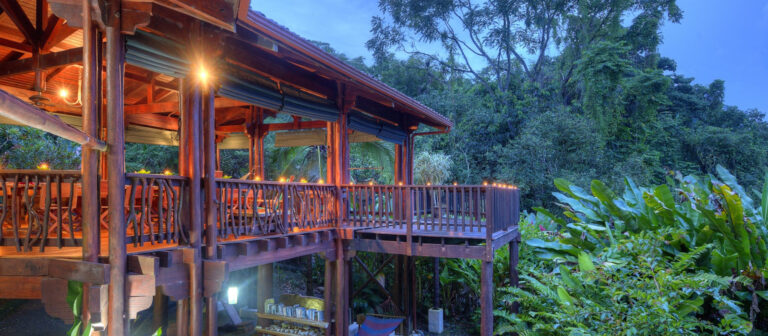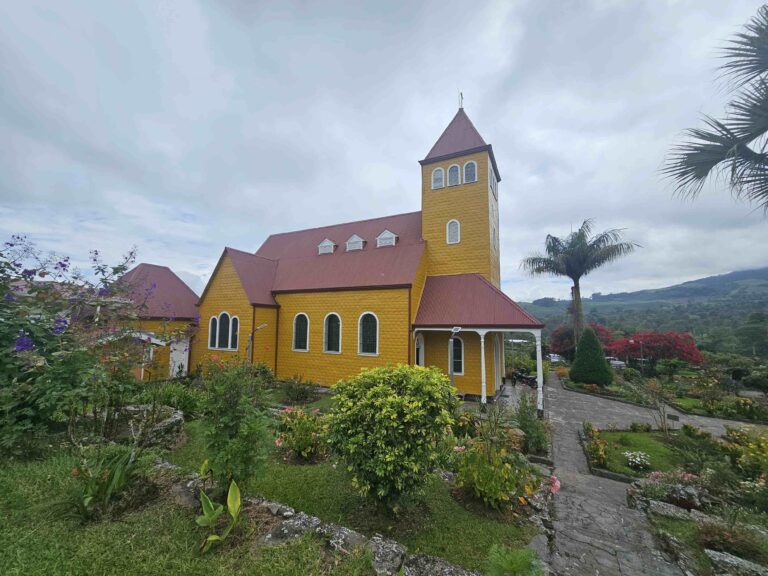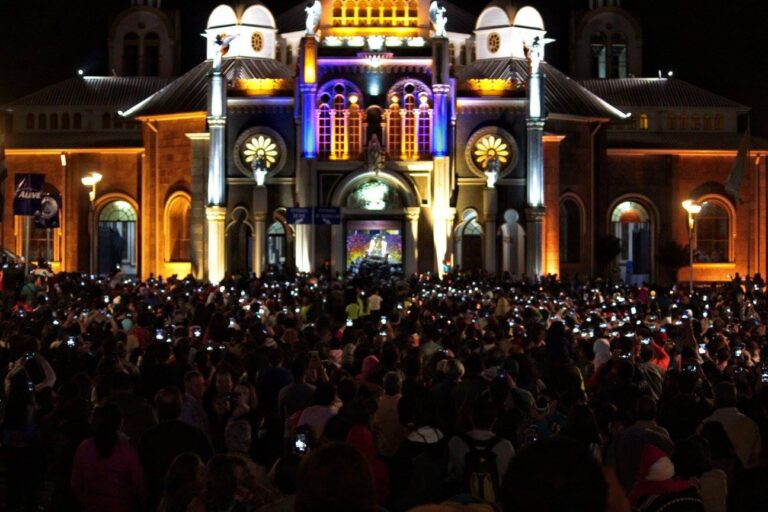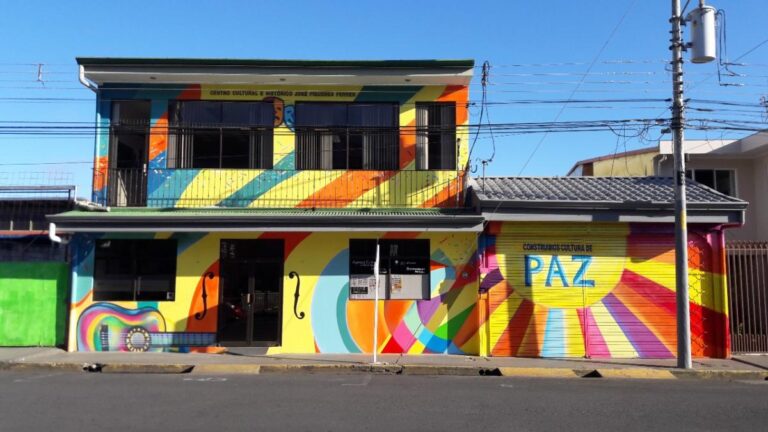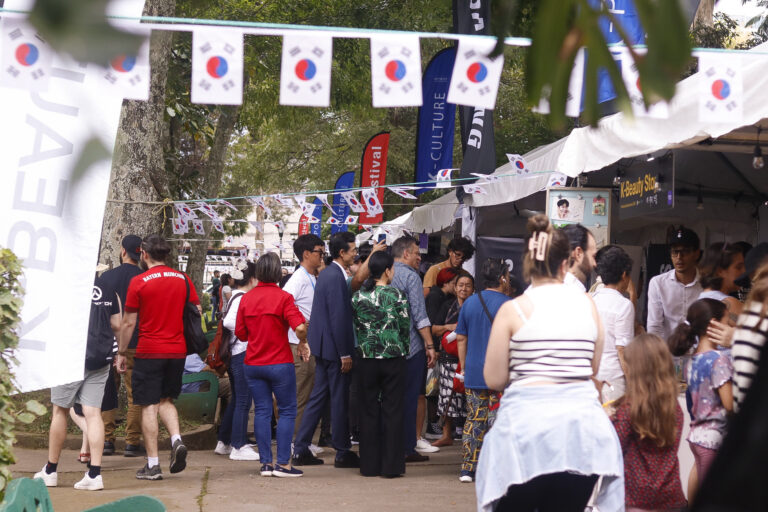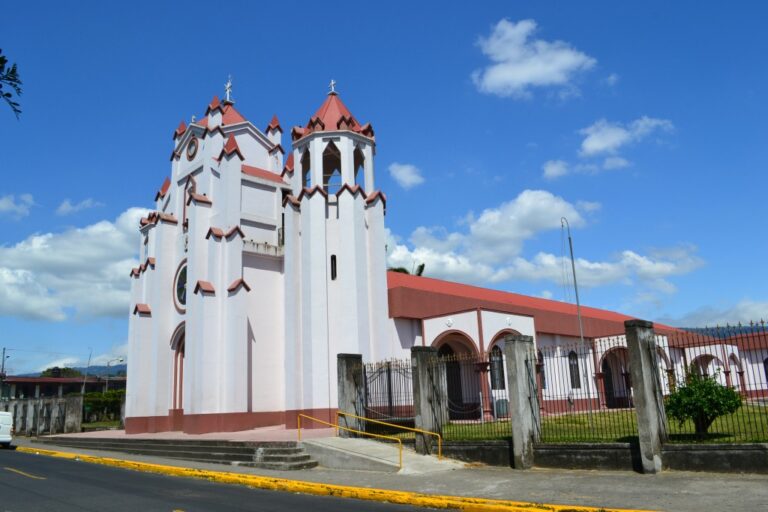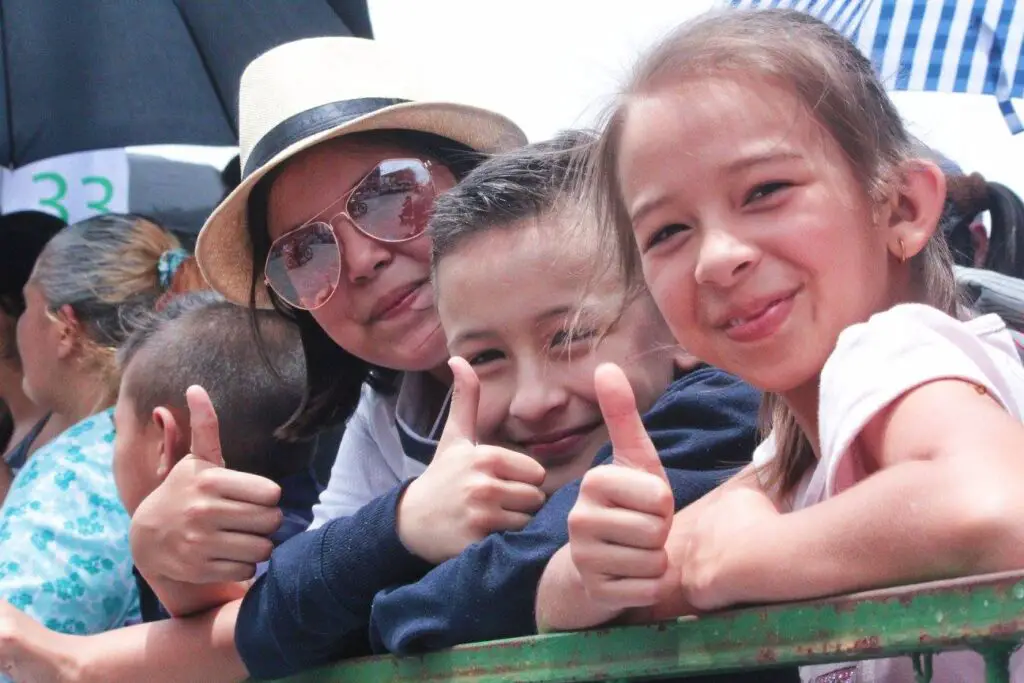Listen to the podcast version of this article
From August 22nd to the 24th, I had the opportunity to discover a hotel and destination that had been on my wish list for months: Nicuesa Lodge. This place has all the attributes to become one of my favorites, and now, it is also available through our agency, Green Circle Experience.
It is a beachfront property, with a practically private beach and crystal-clear waters that receive the gentle waves of the imposing Golfo Dulce, on the Osa Peninsula—one of the few tropical fjords on the planet—and adjacent to Piedras Blancas National Park. A true oasis of nature, peace, and relaxation.
What follows is the narration of an experience that I am sure I will repeat every year, if not more frequently.
The beging of the journey
At 7:00 a.m., I arrived at the domestic flights terminal of Juan Santamaría Airport. The wonderful people at SANSA had been kind enough to coordinate my outbound and return flights. The air terminal is, literally, what every airport should be: a simple and quick entry, an agile check-in—my name was already on the list—and after showing my ID and going through security, I went directly to the boarding area.
A small tip from personal experience:
The SJO terminal is the most modern and complete of the domestic flight terminals in Costa Rica; the regional ones are usually more basic. At the security check, luggage passes through an X-ray and passengers go through a metal detector.
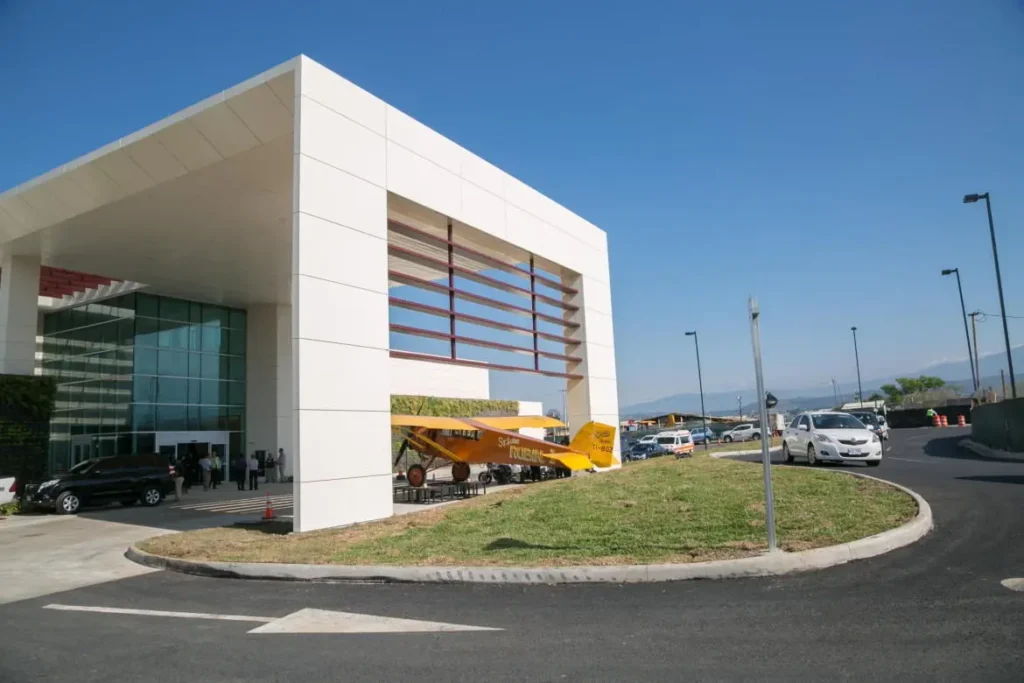
On that particular Friday, I had a Swiss Army knife in my suitcase. It’s something I always carry when I road-trip through the country. I rarely use it, but it gives me an added sense of preparedness, especially since I love getting lost in the forest. The security officer spotted it right away and told me that to take it with me, I’d have to do a full baggage check.
This process involves unpacking and logging every single item in your luggage in front of an official. It can be a hassle, particularly when you have other passengers staring while they wait behind you. Luckily, the SANSA agent offered to keep it in the airline’s storage facility for me until I came back. She handed me a claim ticket with the code for the storage box, making it simple to pick up when I returned on Sunday.
I’m sharing this story because it could happen to any traveler: you get used to carrying an item that’s allowed at regional terminals, only to find out it’s restricted at SJO. And no one wants to be in a hurry and have to choose between checking all their luggage or parting with a tool that has practical or sentimental value. This is especially important to consider if you won’t be flying back from SJO, which could make getting your item back much more difficult. In any event, thanks again to the Sansa staff for their helpfulness and for taking care of my knife, which is indeed very sentimental to me.
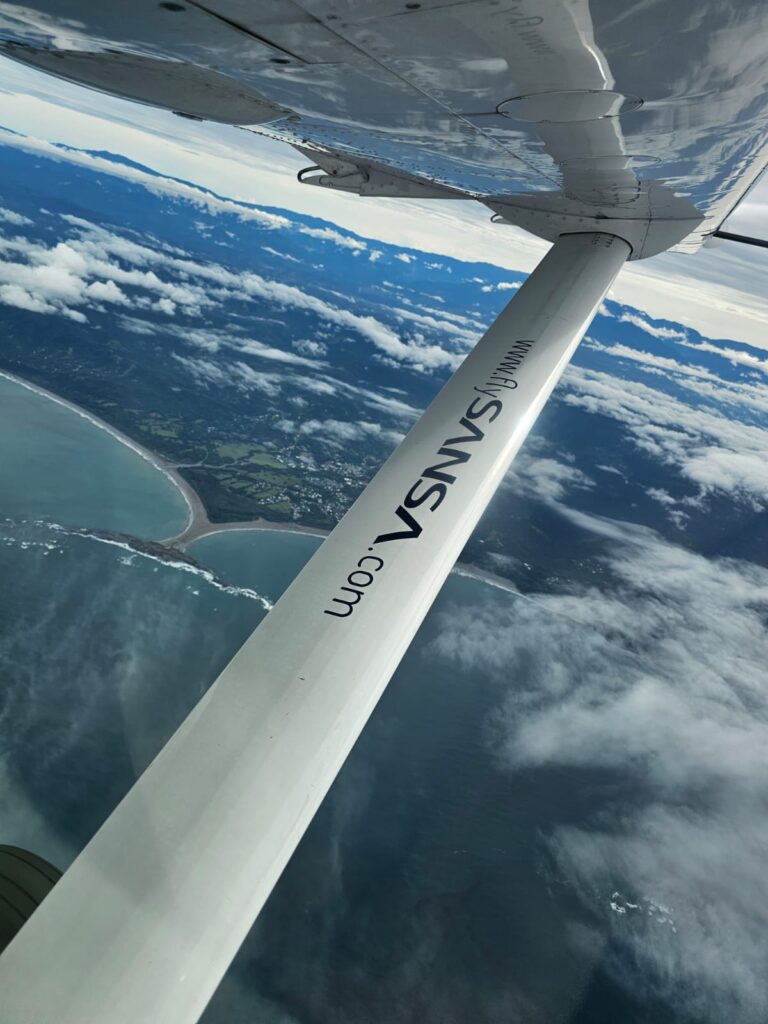
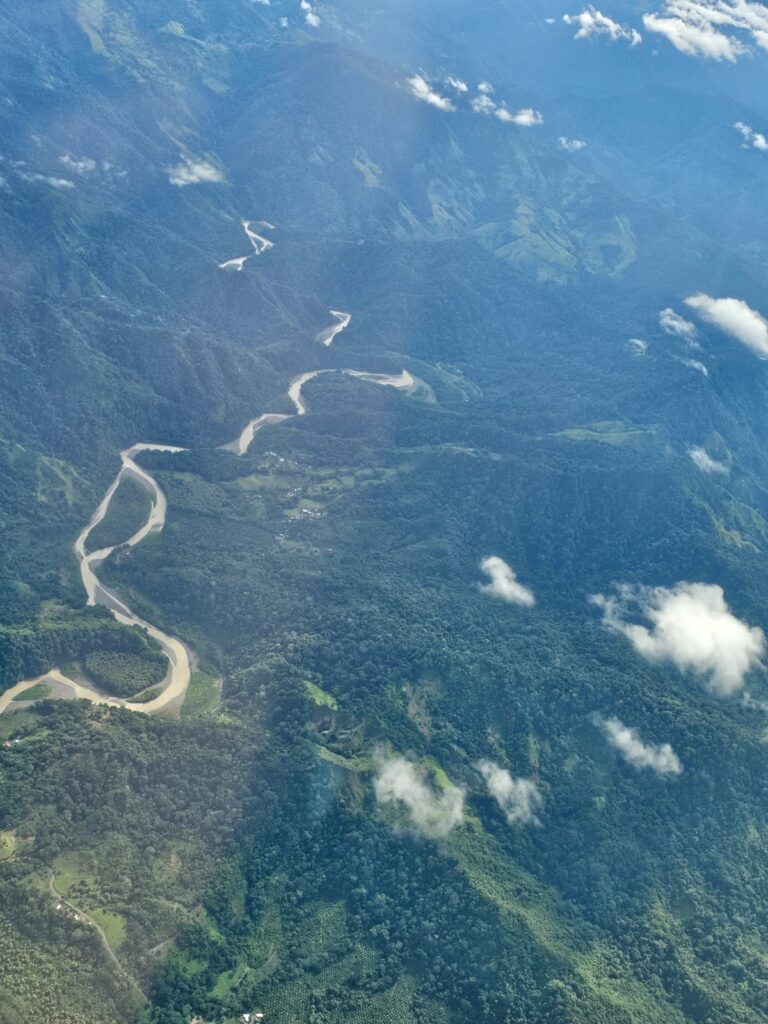
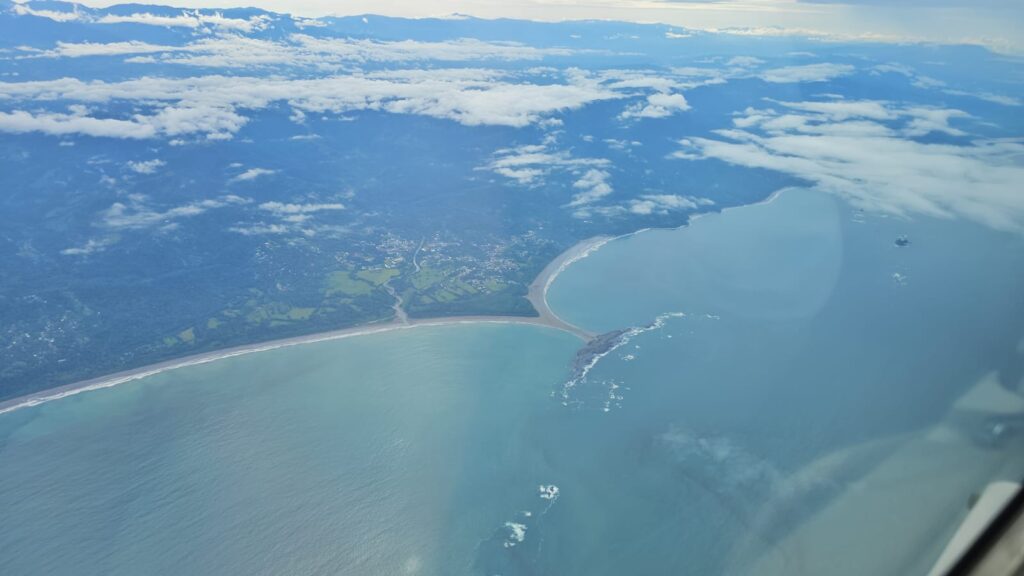
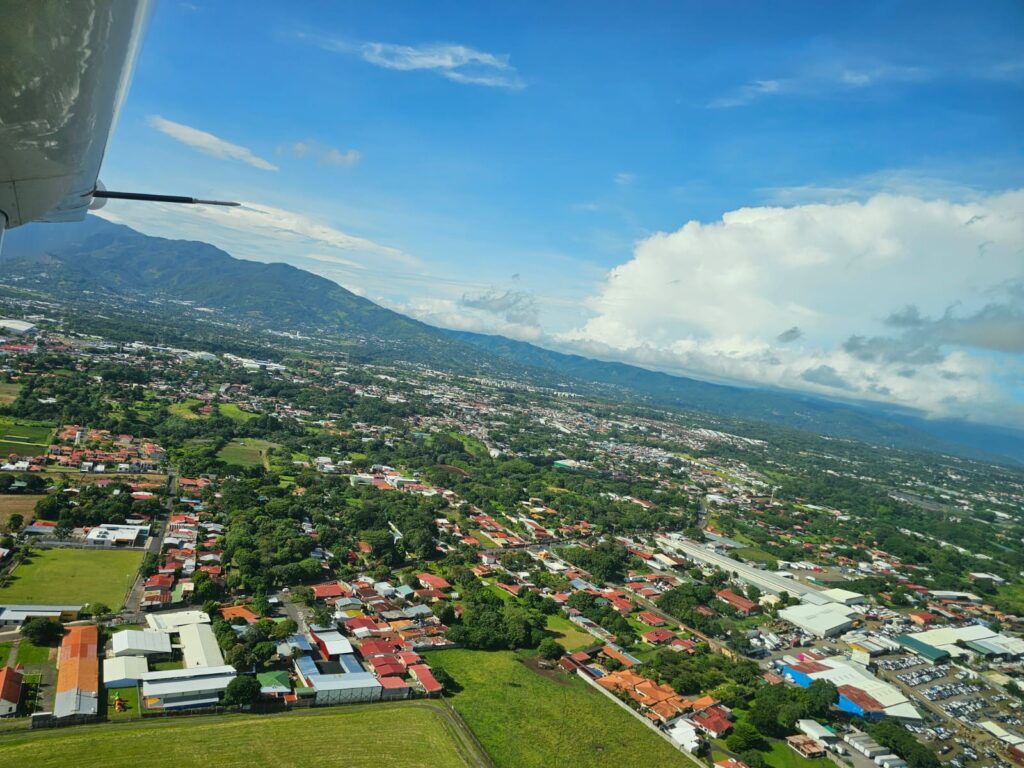
The experience begins with the Cessna Caravan aircraft.
With a fleet of twelve Cessna Caravans, SANSA connects 14 destinations: twelve inside Costa Rica and two international routes to Nicaragua and Panama.
I have to admit, I still get a little thrill of childlike excitement when I board a plane. The crew—a pilot and a first officer—usually waits by the aircraft during boarding to greet each passenger. Once everyone is settled and the doors are shut, takeoff happens almost right away.
The Cessna Caravans can hold 12 passengers. While the ceiling isn’t very high, the cabin is comfortable, and the seats are good enough to even take a nap in. The sound of the engine and propeller is definitely noticeable, but it’s no more bothersome than the rumble of an old bus. The moment the wheels lift off the runway, your focus shifts to what truly matters: the scenery below. The engine noise fades into a background hum, setting the soundtrack for the vibrant scene unfolding outside your window.

As we head toward the Pacific, the first thing I see are the streets and highways of Alajuela, still choked with traffic at 8:00 a.m. as thousands of Costa Ricans make their way to work.
Costa Rica is a country simply bursting with green. On the ground, I often think about what a privilege it is to live where trees aren’t a novelty, but a part of everyday life. From the air, however, the sheer scale of that greenness is even more overwhelming. A simple flight with SANSA turns into a scenic tour, a reminder of how lucky one is to live in or visit this incredible land.
The plane crosses mountains, valleys, and canyons, flying over plantations, winding rivers, and lazy meanders. From this height, you can pick out the scattered houses typical of small Tico towns. Gradually, the terrain flattens out, and the rivers begin to fan into deltas as they empty into the Central Pacific.
The pilot announces we are passing over Quepos: skies are clear, with no other aircraft in sight. I’m surprised by how the Pacific looks—the water is clear, shimmering in green and blue with gentle waves. It’s the rainy season, and August brought heavy downpours, so I was expecting the coast to be murky with sediment. The reality was crystal clear.
Then, a rush of anticipation gets the best of me. My right leg starts bouncing, waiting for the iconic Whale’s Tail to appear. This unique landform is created by sediment buildup and rocky reefs that jut out into the sea, forming a sand-spit isthmus that’s only visible at low tide. Years ago, it was even covered in trees; today, what remains is its unmistakable silhouette in the middle of the ocean. We’re over Uvita, and on this trip, we don’t even need to see whales.
Our flight continues down the coastline, leaving Uvita behind. Now we’re flying over an intricate labyrinth of channels and mangroves. Below us is Sierpe, one of my favorite places for a boat trip—a place I consider a kind of Costa Rican Amazon, right up there with Tortuguero.
Soon, we leave the shore behind and enter an ecosystem where land and freshwater rivers merge on their journey to the sea. From the air, the mosaic is hypnotic: a tapestry of rivers, swamps, strips of jungle, and estuaries that seem to breathe in rhythm with the tide.
A few minutes later, the landscape shifts once more. We are now flying over the Golfo Dulce Forest Reserve and the vibrant Corcovado National Park, one of the most biodiverse jewels on the planet.
And then, all at once, the sea is back. But this is different. What appears beneath our wings is a fjord. Yes, a tropical fjord.
What is a Fjord?
A fjord is a narrow, deep inlet of the sea that cuts deep into a coastline, surrounded by steep mountains or high cliffs. They are typically formed when a glacier carves out a U-shaped valley, which then floods with seawater after the glacier retreats. When you think of fjords, Norway is the country that comes to mind.
But tropical fjords are a different story entirely. They are extremely rare—only four exist in the whole world—and the one in Costa Rica is especially unique. Its origin isn’t glacial, but tectonic.
Here is the complete list for you to add these destinations to your travel bucket list.
| Tropical Fjord | Contry / Region | Origin | Max Depth | Notable remarks |
| Golfo Dulce | Costa Rica | Tectónico | ~200 m | Anoxic basin below 100 m; sanctuary for humpback whales and hammerhead sharks. |
| Golfo de Cariaco | Venezuela | Tectónico | ~140 m | Warm and calm waters, high fishery productivity. |
| Bahía Darwin | Islas Galápagos (Ecuador) | Tectónico | ~200 m | Unique marine biodiversity, part of a submerged crater. |
| Bahía de Kaoe | Indonesia | Tectónico | ~300 m | Surrounded by tropical rainforest and coral reefs. |
👉 Para conocer más sobre la riqueza natural del Golfo Dulce, te invito a visitar CostaRicaSpecies.com.
Arrival at Puerto Jiménez
The plane begins its descent. The ground rushes up to meet us, and the feeling is dizzying. Now, close to the sea, transport and fishing boats zip by at full speed beneath our window. The descent continues, our apparent speed picks up, and within seconds, we’ve left the boats behind, left the sea behind… and we touch down on the runway at the Puerto Jiménez airport, Costa Rica’s newest canton.
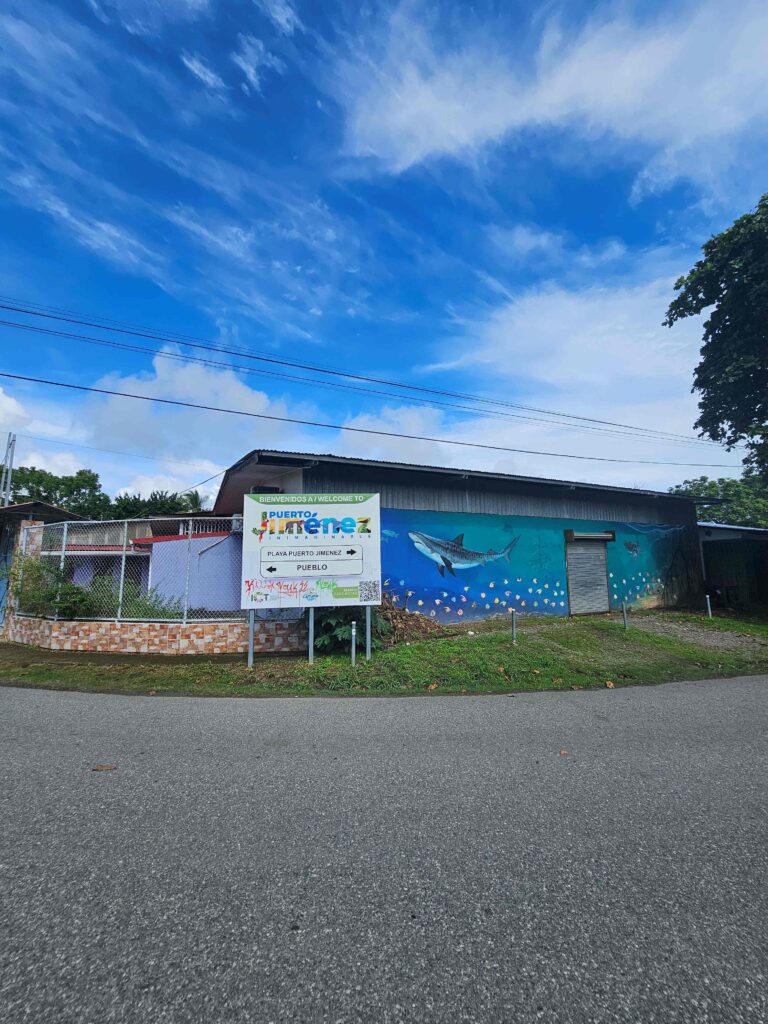
There, to welcome us, a black dog appears, wandering with the calm of one who is already accustomed to the coming and going of airplanes. It barely moves off the runway, more to avoid the roar of the engine than out of fear of ending up under the wheels. An authentically Costa Rican postcard to end the flight.
-As a curious fact, the Puerto Jiménez airport is adjacent to the community’s cemetery. I will let the reader’s humor make the following analogy…-
Landing.
Nicuesa Lodge is a unique ecolodge that can only be reached by water. The hotel provides boat transfers from the docks in either Golfito or Puerto Jiménez. Conveniently, SANSA flies to both of these towns, making the connection easy.
For guests who prefer to drive, Nicuesa has an arrangement with the Golfito marina for parking at $10 per night. The marina is also equipped with electric car chargers.
My Friday flight was to Puerto Jiménez and took exactly 45 minutes. Mornings in Costa Rica, even during the rainy season, tend to be calm and clear, and the Cessna Caravan provides a stable, smooth flight.
While I personally love driving through Costa Rica and exploring its towns, there’s no question that trading a five-and-a-half-hour drive for just 45 minutes of incredible aerial views is an experience worth every penny.
Puerto Jiménez, the youngest cantón of Costa Rica.
Officially, Puerto Jiménez is Costa Rica’s newest canton. It became the country’s 84th on April 8, 2022, with the signing of Law 10.195. As I write this, it has only been in existence for about three years.
Here’s a practical tip: this is your last chance to stock up before heading out. Just ten meters from the airport, there’s a small corner store, or pulpería (I promise I’ll remember its name on my next visit). This is your final opportunity to grab any forgotten essentials—yes, even a Swiss Army knife—before you venture deeper into the Golfo Dulce.
For those of us who are mosquito magnets, the shop has everything necessary: repellent, sunscreen, and flashlights, along with snacks, drinks, and ice cream for anyone with a sweet tooth.
👉 Más adelante encontrarás nuestra lista recomendada de cosas para empacar al visitar el Golfo Dulce y la Playa Nicuesa.
Heading to Nicuesa Lodge
The moment we stepped into the Puerto Jiménez terminal, the Nicuesa Lodge staff was already there to meet us. We were greeted by Kimberly and Oscar, who were warm and smiling, with that effortless way of making you feel right at home from the very first minute. They introduced themselves, welcomed us, and immediately took charge of our luggage, loading it into a taxi driven by Oli (Olivier), our taxi and boat captain.
The taxi ride to the dock is just three minutes long. Honestly, we could have easily walked, but with luggage in tow, the convenience was much appreciated. Our boat was already waiting at the dock, ready to whisk us away to Nicuesa.
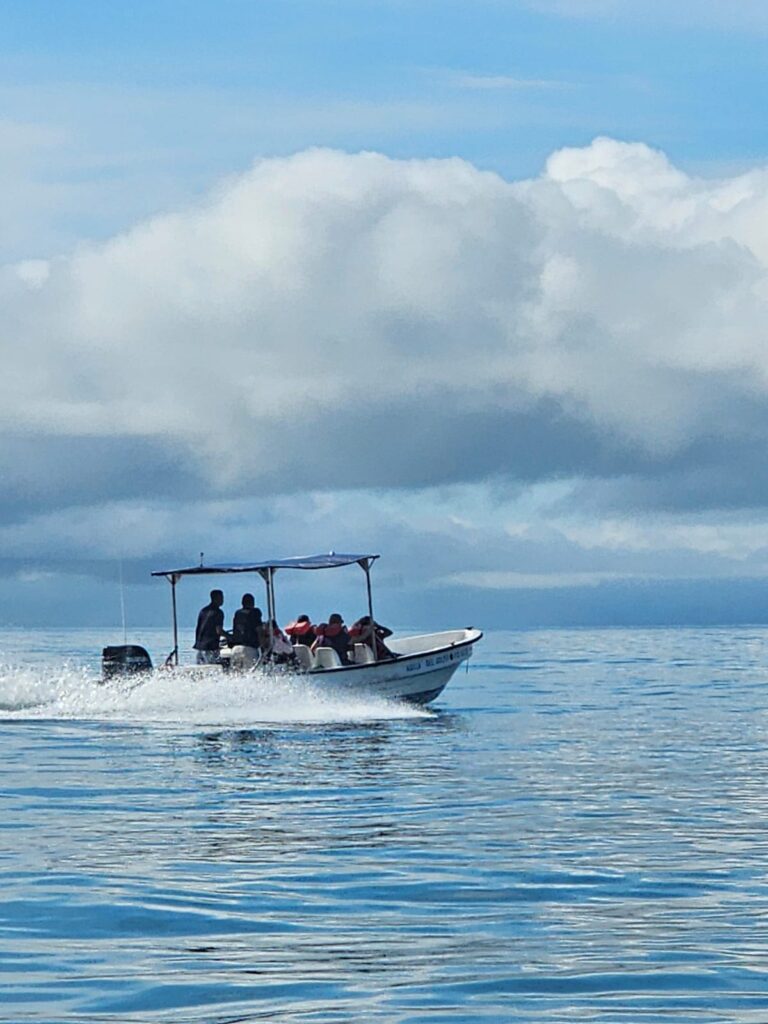
The Golfo Dulce: A Mirror of Calm
A fascinating feature of the Golfo Dulce is its almost complete lack of waves. Navigating its waters is like gliding across an infinite swimming pool—a placid, serene lake that perfectly mirrors the sky. One look is all it takes to understand why humpback whales choose it as their sanctuary.
The boat ride from the Puerto Jiménez dock to Nicuesa Lodge takes about 20 minutes. The ecolodge is located almost in a straight line, directly across the gulf. The journey is so smooth that for anyone prone to seasickness or with a sensitive inner ear, it feels less like a sea voyage and more like a gentle bike ride through the city.
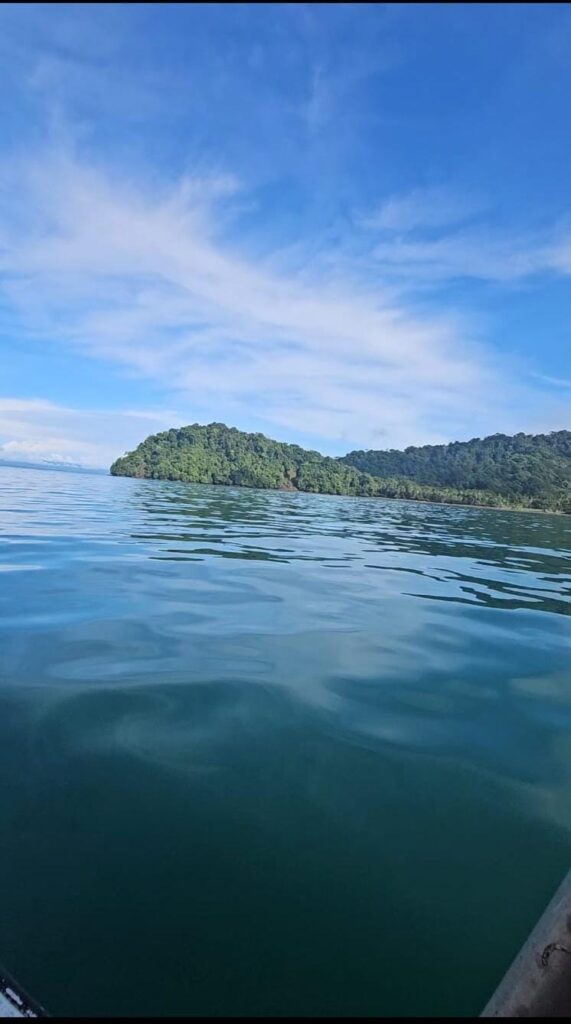
Arrival at Nicuesa
Twenty-five minutes after leaving Puerto Jiménez, we arrived at the Nicuesa Lodge dock. As simple as it is, the dock is something you’re incredibly grateful for. Getting off a boat directly onto a beach while carrying luggage always involves a bit of mental gymnastics to time your jump. Here, there’s no hesitation: the dock removes all that awkwardness and saves you from having to test just how waterproof your suitcase really is.
When we arrived, the hotel staff greeted us with a refreshing fruit juice. After a brief orientation and a warm welcome, they took our bags to be delivered to our rooms, while we headed to the lobby to check in.

A Cacao Farm Reborn as a Sanctuary.
The land where Nicuesa now stands was originally a cacao farm that fell into decline with the arrival of the monilia fungus (Moniliophthora roreri), also known as frosty pod rot. This fungus attacks young cacao pods, making them unusable for harvesting and producing chocolate. The disease, first detected in Costa Rica in 1978, hit the native criollo varieties especially hard, although others, like the trinitario, proved to be more resistant.
Devastated by the plague, the old owners decided to sell. The farm was then purchased by a couple from New York who were determined to transform it into a nature sanctuary while also creating a space for travelers and nature lovers to stay. This was the birth of a true ecolodge, founded on the principles of sustainable tourism.
What is a True Ecolodge?
You’ve surely come across the word “ecolodge” before, but what does it really mean? How is it defined? How can we tell if a destination is a genuine ecolodge and not just a buzzword that’s more about marketing than reality?
Here’s the breakdown:
An ecolodge is a type of tourist accommodation that is designed, built, and operated to minimize its environmental impact and benefit local communities. It is typically situated in a natural environment—like a rainforest, mountain range, or ecological reserve—offering guests an immersive experience in nature.
Based on this definition, Nicuesa, along with the other properties in the Green Circle Experience, fulfills every one of these characteristics.
Nicuesa’s Lobby and Restaurant
Because the hotel is so remote, the lobby and restaurant are the only areas with internet access. The rooms, while beautiful, have no TV, no Wi-Fi, and no air conditioning. For some travelers, this might be a deal-breaker. But for anyone looking to truly disconnect, experience nature in its purest form, and escape the constant barrage of social media, Nicuesa is a paradise.
In the lobby, the staff is always available to help, answer questions, or simply chat with guests. The upper level houses the bar and restaurant, both built—like every structure at the lodge—from responsibly harvested wood from the property itself. You enter barefoot, a small detail that deepens the feeling of connection to the place.
The food is traditional Costa Rican, though it’s not served as a casado (a typical platter-style meal). There’s no à la carte menu; instead, the hotel offers a few different balanced and delicious options each day. Vegetarian choices are available, but protein is usually the star of the plate, staying true to local culinary style. Coffee is always on, and the homemade coconut cookies were a huge hit with everyone.
The restaurant boasts an idyllic view of the Golfo Dulce, a constant reminder that your next adventure is just a splash away—whether it’s exploring the fjord by boat or, during the right season, spotting whales in their natural habitat.
One detail I absolutely love about Nicuesa is that meals are served at a large communal table where guests can sit down together, chat, and share stories. The lack of digital distraction, the chirp of cicadas, the sea breeze, and the gentle lapping of waves on the pebble beach all make socializing feel effortless. In a way, I think it’s the most natural way to connect with people—gathered around candlelight at night or surrounded by the calls of birds, monkeys, and macaws by day, just as our ancestors did for millennia.
Rooms: Jungle Sanctuaries
Nicuesa Lodge has several lodging options, each designed to blend seamlessly with the surroundings and let nature take center stage. Every room features hardwood floors, louvered doors and windows, ceiling fans, a private terrace, an open-air shower with a jungle view, and direct access to the rainforest. Each space is an invitation to breathe deeply, be present, and disconnect.
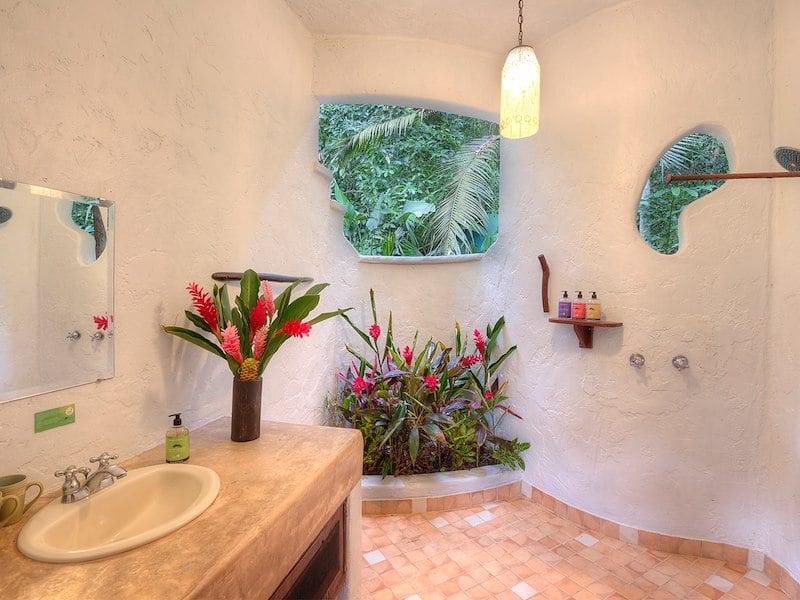
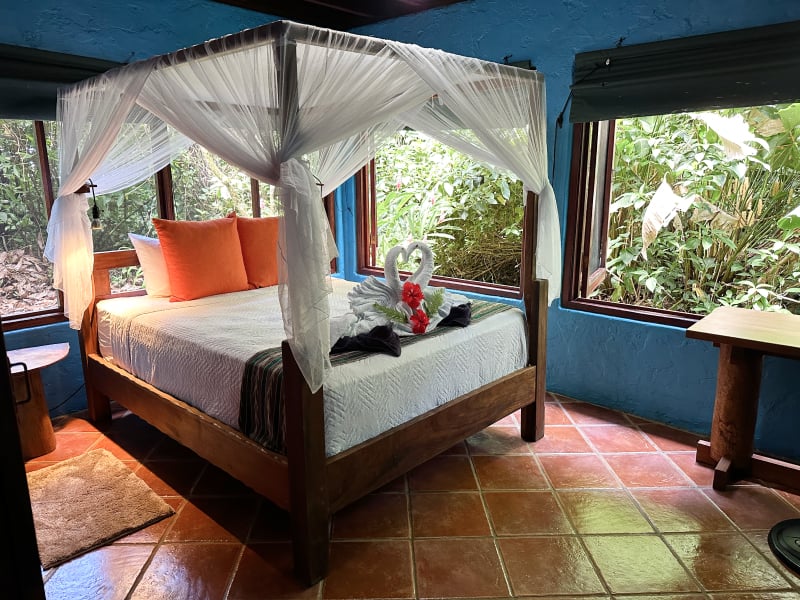
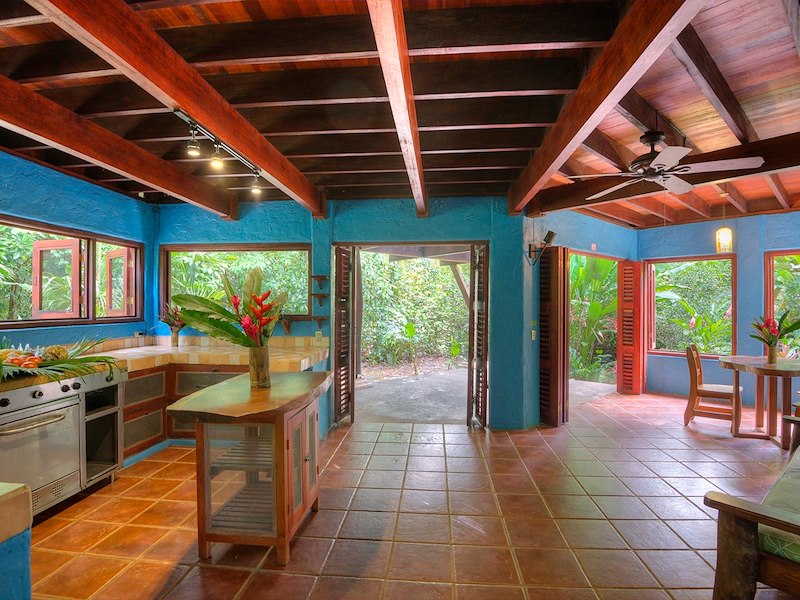
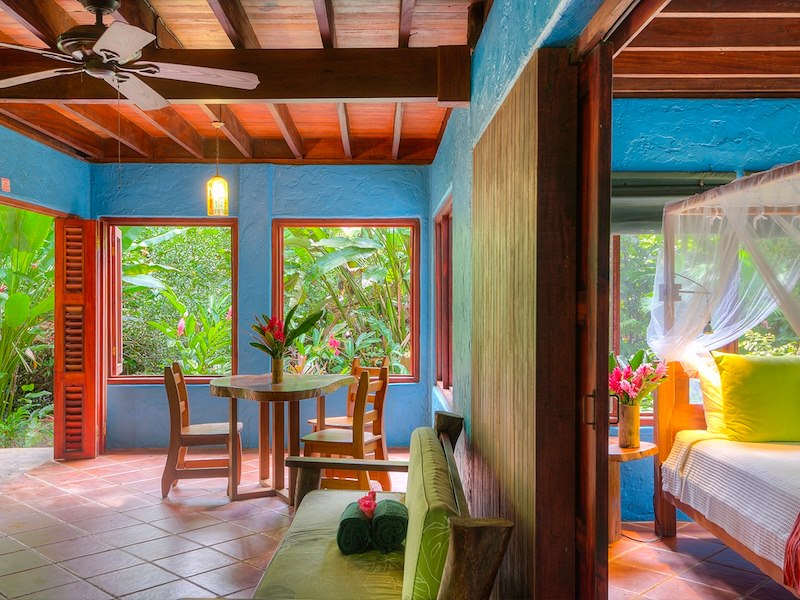
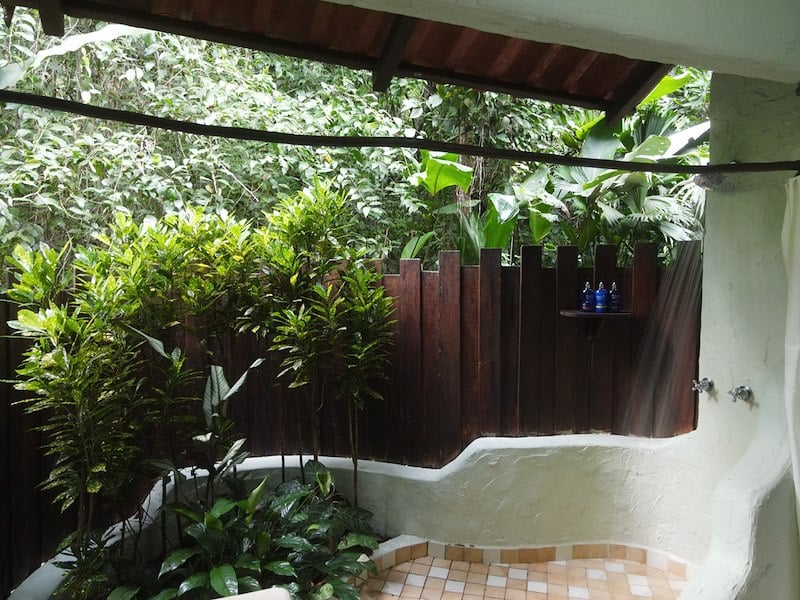
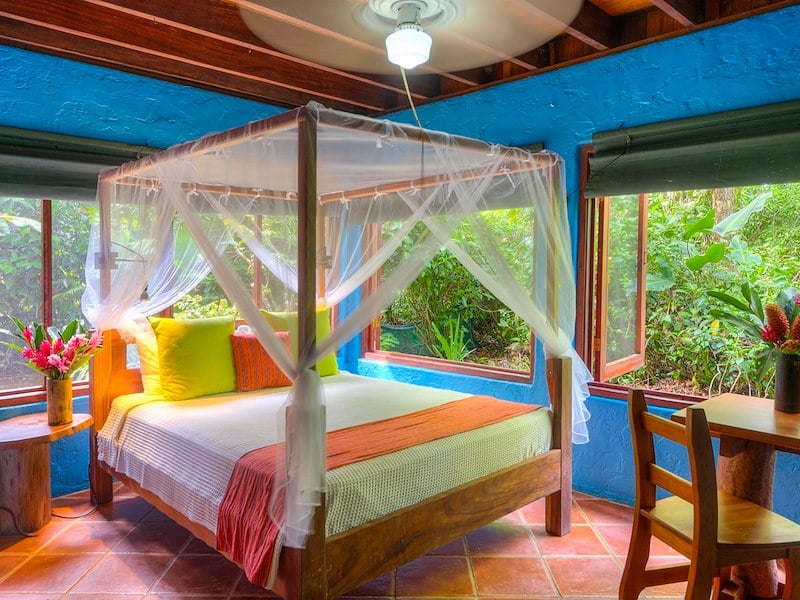
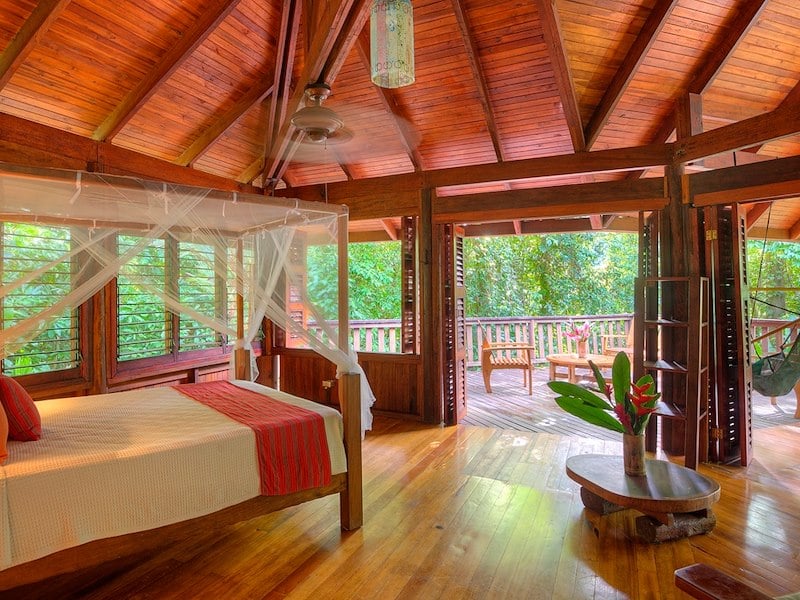
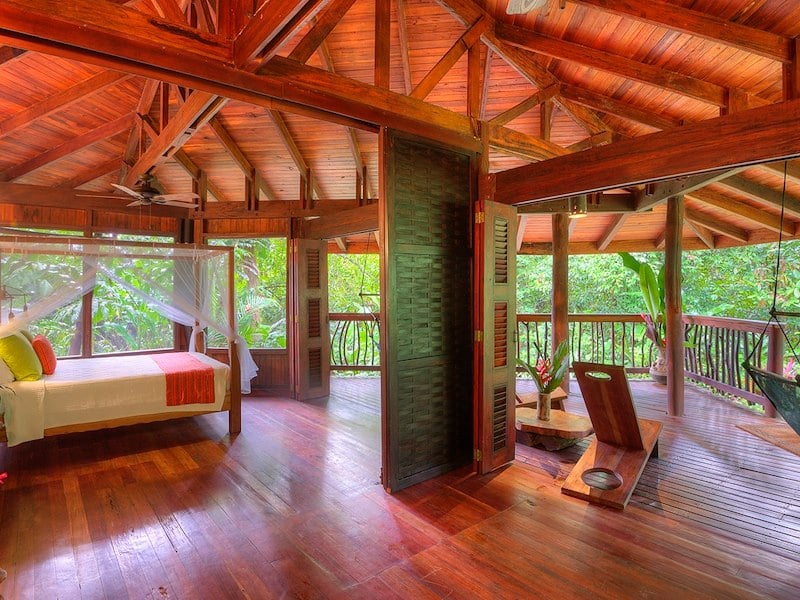
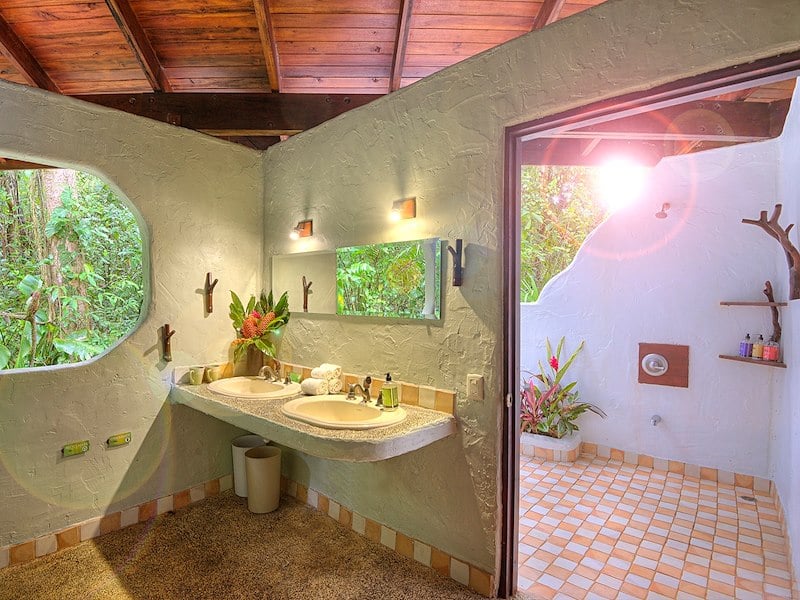
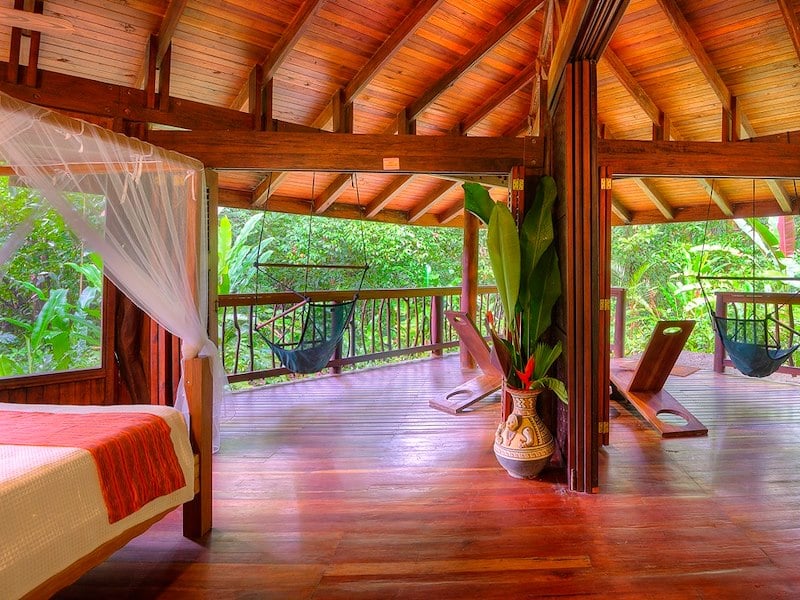
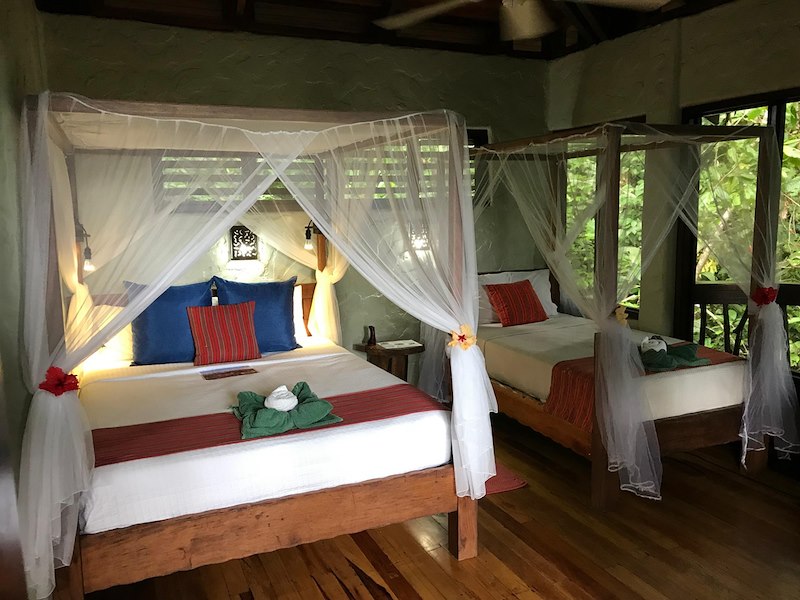
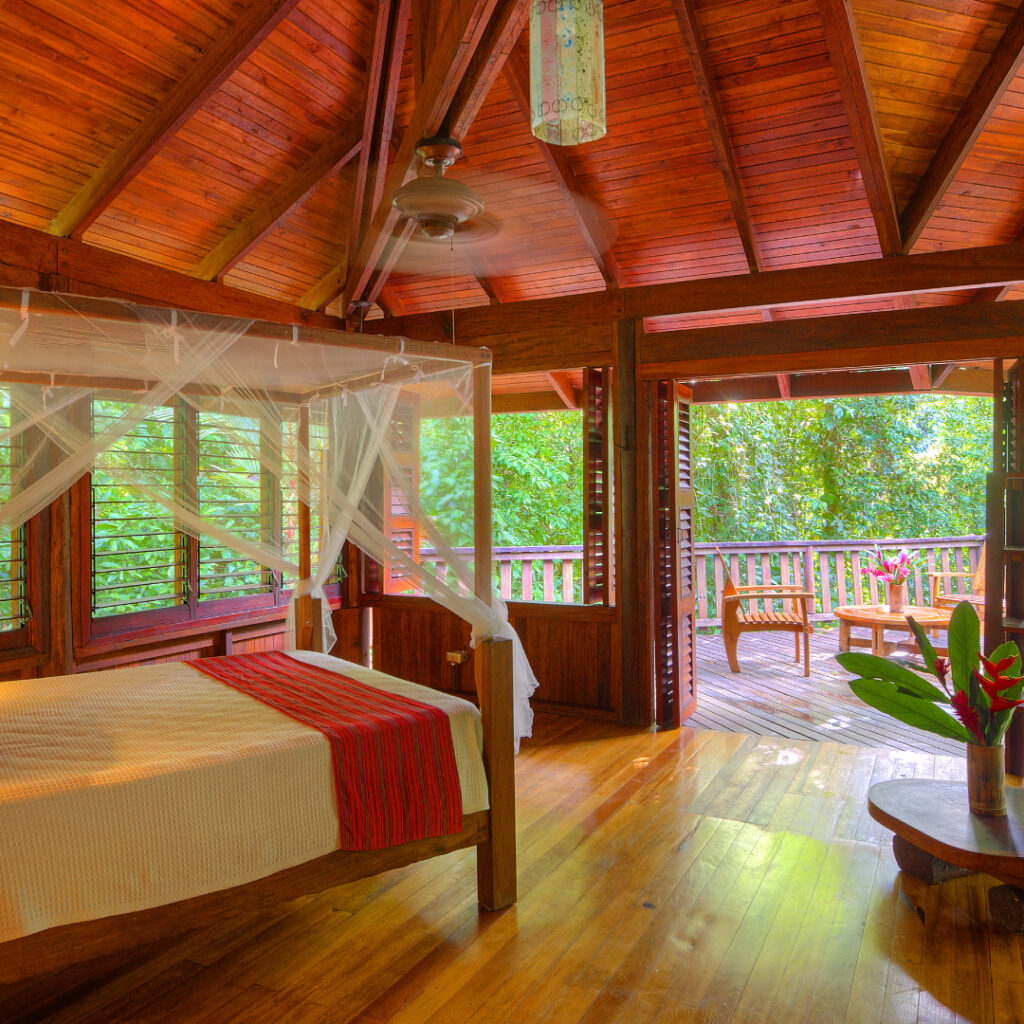
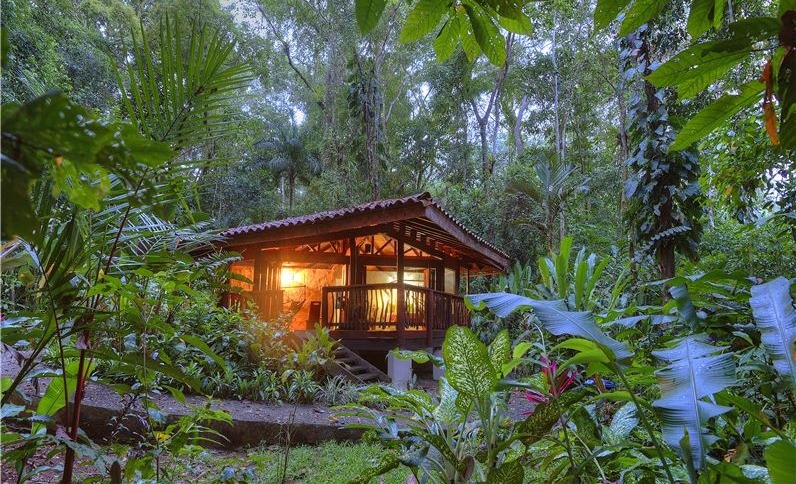
Available Cabins and Suites
- Mango Guest House Rooms: A stylish two-story, “jungle-chic” building offering panoramic views. These spacious rooms are perfect for couples or small groups of 2-3 guests and feature a private terrace, an open-air bathroom, and a choice of a queen bed or double and twin beds.
- One-Bedroom Cabin: For those seeking ultimate silence and privacy, these more intimate cabins are perfectly nestled within the lush vegetation. They feature a separate bedroom, a wrap-around terrace, and a shower with a stunning jungle view.
- Cabin Suite: This versatile and more expansive suite can be configured either as two separate bedrooms or as one bedroom with a large living area. It’s the perfect choice for guests who desire more room to spread out while still enjoying an intimate setting.
- Two-Bedroom Cabin: Ideal for families or groups, this cabin includes two bedrooms and a convertible living room to accommodate additional guests. With a private terrace and all the amenities, it offers everything you need to feel at home while completely surrounded by nature.
Jaguar House: My Jungle Sanctuary
I was fortunate enough to stay in the Jaguar House, which was once the owners’ private home. This two-story, three-bedroom house is a perfect blend of space, comfort, and the feeling of being completely enveloped by the wild.
The first floor has a cozy living room, a comfortable bedroom, and a full bathroom complete with an open-air shower. To wake up there is to listen to the sounds of the forest and watch the light filter through the leaves.
The second floor is a loft-style space that holds the master bedroom, an additional room, another bathroom, and a large, open terrace from which you can hear the distant murmur of the Golfo Dulce. It’s a space designed for recharging—a place to read, contemplate, breathe, and let the sounds of nature fill the silence.
The layout also creates a wonderful shared retreat, perfect for traveling with family or friends. Everyone has their own private space, yet all are connected to the jungle, the fresh air, and the stunning views. Being on the upper floor allows the gentle sounds of the sea to drift in, mingling with birdsong and the cool breeze.
Every morning at Jaguar House begins with a symphony of sounds that only a place like this can provide: birds, insects, the wind, and maybe even a curious monkey or reptile. At night, the darkness reveals millions of stars, far from any artificial light, wrapped in a silence so profound you can hear your own breathing.
A Few Extra Tips for Your Stay.
- Logistics: Once you’ve booked, the hotel staff handles all the logistics for you, including your itinerary, pickup, and transportation to and from the docks at either Puerto Jiménez or Golfito.
- Planning Your Itinerary: If you’re visiting multiple hotels, I recommend making Nicuesa Lodge either the very first or the very last stop on your trip. The best way to get there is with an 8:00 am flight from Sansa, which allows you to take advantage of the clear morning weather. This is especially true if you’re traveling during the green season (May-Nov) or for the whale watching season in August and September.
- Navigating at Night: The paths between the cabins, the lobby, and the beach are not lit up at night. This is done intentionally to avoid disturbing the local wildlife and to keep insects away from the rooms, in line with true ecolodge principles. The paths do have small blue reflectors (like cat’s eyes on a road) to guide you, but it is essential to carry a flashlight or headlamp when walking around after dark. The cabins come equipped with flashlights, but we suggest bringing your own as a backup.
- Policies and Packages: The minimum stay is two nights. The lodge offers 2 and 3-night packages that include all three meals and activities such as whale watching, guided night hikes, cacao workshops, and yoga classes. Before you board the boat to the lodge, double-check that you have everything you’ll need. If you do need to go back to town, you can charter a boat to Golfito or Puerto Jiménez for an extra fee, but you must return to Nicuesa by 3:00 p.m. to ensure the boat can travel safely in daylight. For safety reasons, the hotel’s boats do not operate on the gulf after dark.
- Dietary Needs: The hotel is fully capable of accommodating dietary restrictions and offers vegetarian, vegan, and gluten-free versions of all its dishes. However, it’s best to inform them of your specific needs before you arrive so the kitchen can be fully prepared to accommodate you or create custom meals.
What to Pack for Nicuesa Lodge
A trip to Nicuesa is more than just a hotel stay—it’s an escape into an isolated nature sanctuary. Your comfort here depends just as much on what you pack as what you choose to leave behind. Here’s a packing list to help you make the most of your experience:
Jungle & Weather Essentials
- Light, Breathable Clothing: Think quick-dry shirts and lightweight pants (convertible ones are a great option).
- Swimsuit: The Golfo Dulce will be calling your name, so you’ll want to be ready for a swim at any time.
- Sturdy Sandals & Closed-Toe Shoes: You’ll want sandals for relaxing at the lodge and beach, and a pair of closed-toe shoes (like hiking shoes or trail runners) for jungle treks and night walks.
- Light Rain Jacket (Optional): Even during the dry season, a brief, intense shower can pop up unexpectedly.
- Sun Protection: A hat or cap and sunglasses are non-negotiable for protection from the tropical sun.
For After Dark
- Headlamp or Flashlight: While the lodge provides flashlights, having your own is highly recommended for navigating the paths between your cabin, the lobby, and the beach at night.
- Biodegradable Repellent & Sunscreen: These are must-haves to protect both your skin and the delicate ecosystem around you.
Tech & Capturing Memories
- Camera or Phone with Ample Storage: You’ll want plenty of space to capture the whales, birds, and stunning landscapes.
- Power Bank: A portable battery is a great idea if you plan on being away from your room for long periods.
- Laptop: You can bring a laptop if you need to. The lobby has a decent internet connection, but be aware that it can be unreliable during heavy rain or high winds.
Personal Comfort & Wellness
- Reusable Water Bottle: Stay hydrated without single-use plastics. The lodge has several cold-water stations where you can refill your bottle.
- Personal Medications: Be sure to pack any medications you need, as there are no pharmacies nearby.
- A Good Book or a Journal: The quiet of the forest and the calm of the fjord are perfect for inspiring reflection and writing.
Optional Extras
- Your Favorite Snacks: While the lodge provides all your meals, it’s always nice to have a few of your personal favorites on hand.
- Binoculars: A must-have for getting a closer look at birds, monkeys, or whales in the distance.
- Snorkel Gear: The lodge provides gear, but you’re welcome to bring your own if you prefer.
Final Travel notes.
At Nicuesa, disconnection is part of the charm: there are no televisions or Wi-Fi in the rooms. Packing with that mentality—bringing the essentials to be comfortable and nothing more—is key to taking advantage of the experience. Here, every object counts and every forgotten item is magnified. Make sure to check your list before getting on the boat, because once the Golfo Dulce is behind you, the only thing left is to surrender to the rhythm of the jungle.
Activities
Snorkeling, Hiking, Whale Watching, Yoga, Birding, and More.
As General Manager César explains, Nicuesa Lodge is packed with activities for every fitness level, all centered around the area’s incredible biodiversity.
For guests looking for low-impact options that are easy on the body and joints, there is plenty to do. The cacao workshop, birdwatching, relaxing on the beach, yoga classes, dolphin and whale watching tours, or a gentle hike on the local trails can easily fill your days. Far from being tiring, these activities connect you with nature and allow for a gentle stretch, promising to leave you feeling revitalized and energized.
For the more adventurous and athletic guests, Nicuesa offers kayaking, more advanced guided hikes that include rappelling into the stunning Piedras Blancas National Park (for safety, this must be done with the hotel’s guides), and snorkeling at San Josecito beach or other nearby shores as part of the marine wildlife tour.
It’s also important to note that you can arrange visits to the nearby towns of Puerto Jiménez and Golfito. The lodge can also help you book third-party inshore or offshore sport fishing trips. For any off-site excursions, just be aware that all boats must return to the lodge by 4:00 p.m. to ensure safe travel in daylight..
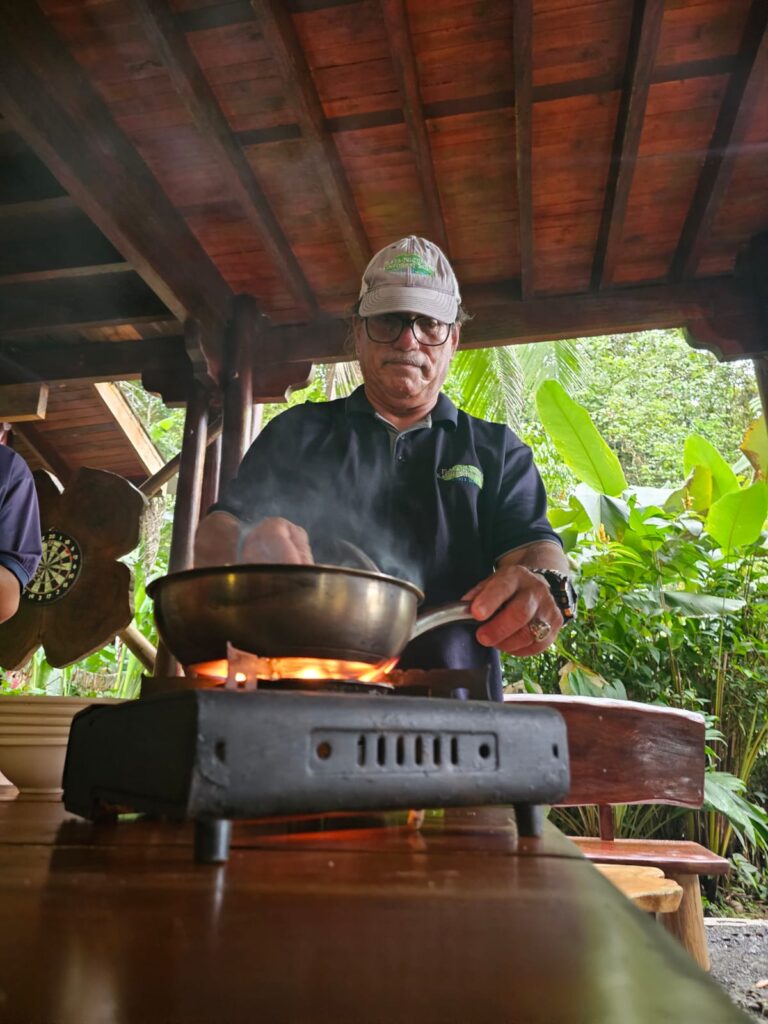
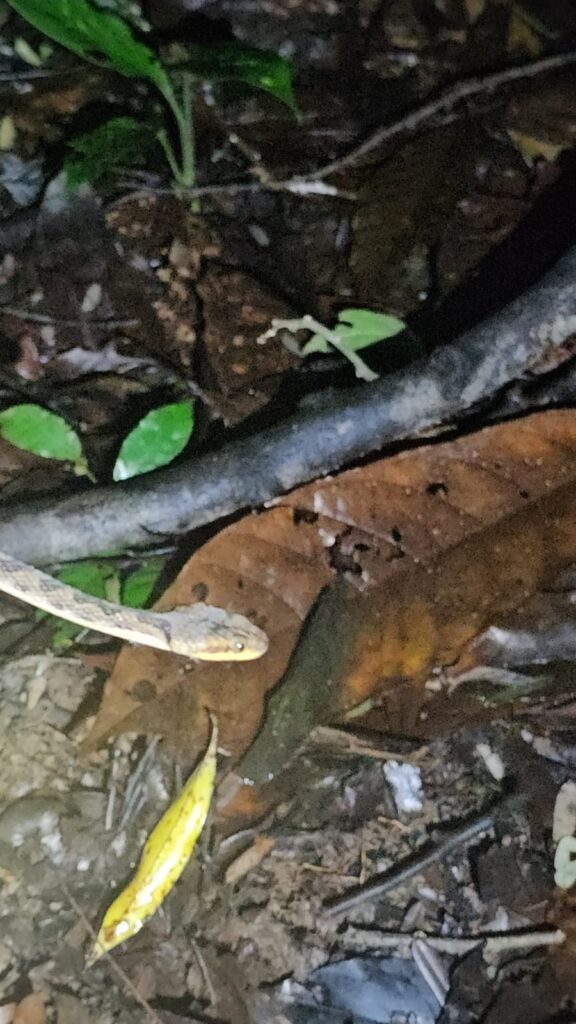
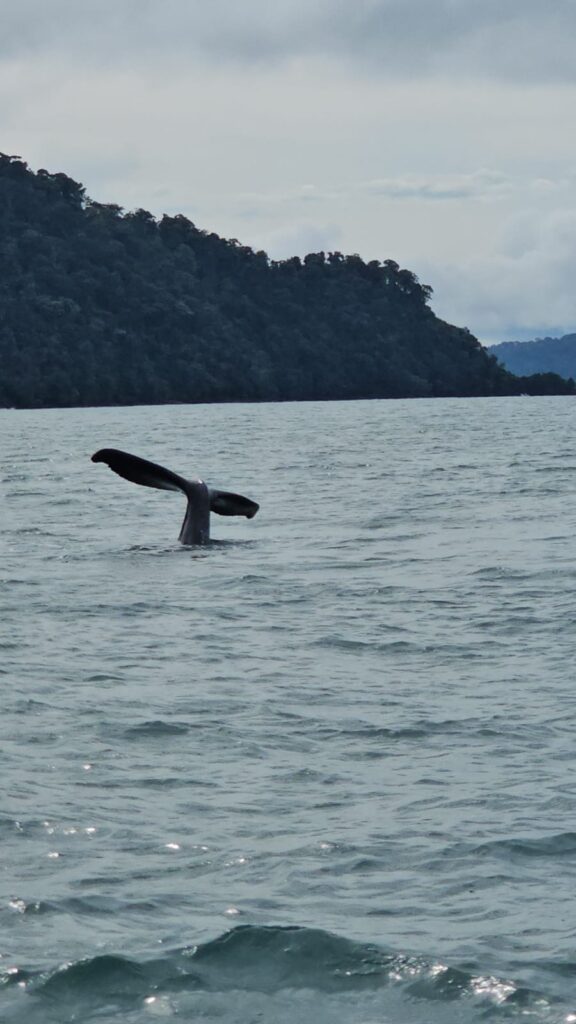
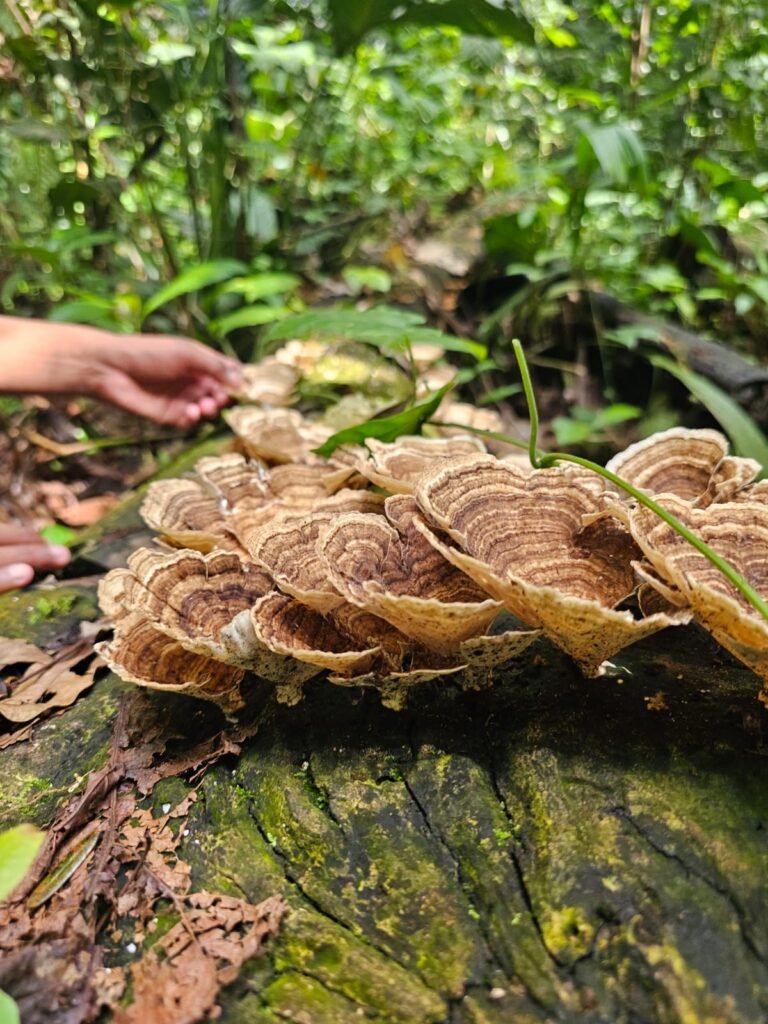
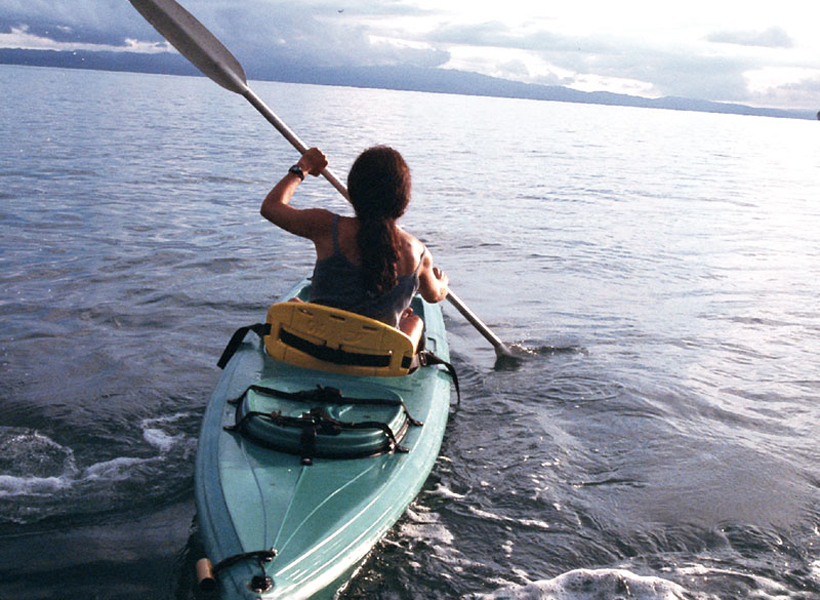
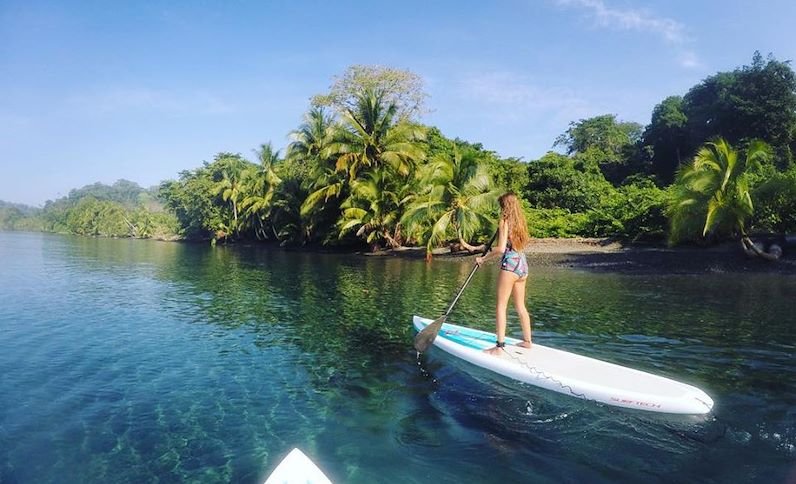
Guided and Independent Hikes.
You’ll find a variety of trails to explore. Most are easy and low-impact, perfect for independent walks (the advanced trail into Piedras Blancas National Park is the main exception). However, the lodge’s expert guides are always on hand to lead themed excursions.
You can join an “Early Birding” tour at dawn to see the forest awaken, or a “Dusk Hike” to witness the fascinating shift from daytime to nighttime creatures. For the night hike, a good flashlight is essential. While the hotel provides them, we highly recommend bringing your own powerful headlamp or flashlight. This ensures you have a reliable light source, especially since the hotel’s supply can run out if a large group decides to go.
The Living Jungle & Whale Season Weather
Remember, the jungle is vibrantly alive, and encounters with Costa Rica’s wildlife are practically guaranteed. You will see insects of all shapes and sizes, and you may see snakes. For your safety, less experienced hikers should always stay on the marked trails.
It’s also important to know that visiting during the peak whale season (August to October) means you’ll be there during the rainy season. Typically, the mornings are bright and clear—perfect for whale and dolphin watching. However, afternoons and evenings often bring powerful downpours and thunderstorms. The staff does an excellent job maintaining the trails and will close any areas if guest safety is a concern. That said, expect the ground to be saturated and muddy. The lodge is fully prepared and offers rubber boots in all sizes for guests. We strongly recommend you use them—otherwise, be prepared for your hiking shoes to finish the trek in a much different condition than they started!
Final Thoughts.
Our final recommendation is simple: go and experience Nicuesa Lodge for yourself. It is a true ecolodge in every sense of the word. It generates its own power, sources its water from natural springs, and serves as a gateway to the incredible Piedras Blancas National Park. Its front yard is the Golfo Dulce, a calm and serene fjord that acts as a nursery for humpback whales and a playground for dolphins. It is a destination that honors the raw grandeur of nature and invites its guests to feel less like owners of the landscape and more like humble cohabitants within it.
Recommendations.
- 2 or 3 nights: Nicuesa is meant to be enjoyed. The recommended minimum stay is 2 nights; the stay includes 3 mealtimes and 3 to 4 activities to choose from.
- Fly and drive or fly only: If the visit to Nicuesa is part of a circuit or if it will be a standalone activity for nationals, the recommendation is to travel to Golfito or Puerto Jiménez by small plane. Turning 5 and a half hours of driving into 45 minutes of an air tour is the best possible idea. It also allows you to make more of the first day, setting foot in Nicuesa before 10:00 am.
- If you are going to drive: There is an agreement with the Golfito marina for parking for $10 USD per day.
- There will be memories: Bring a flashlight, a light raincoat, and a camera or good space on your cellphone.
- Check 3 times before getting on the boat: Nicuesa is remote. The price includes transportation to and from the hotel; any transfer to Golfito or Puerto Jiménez is charged separately. Remember to check everything before setting sail—medications, personal articles, or any necessary item should get on the boat with you. If you forget something, take advantage of either Golfito or Puerto Jiménez to get it, otherwise, there is no way to get it at the hotel except with a transfer.







